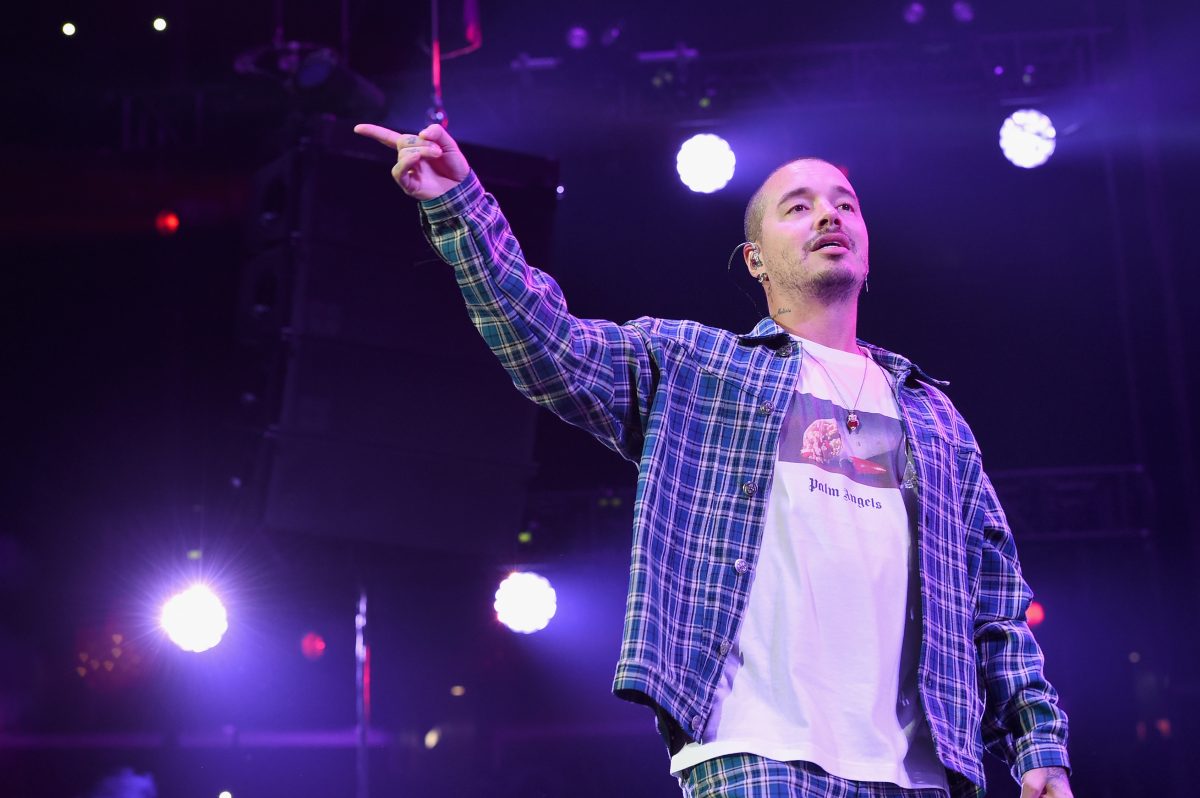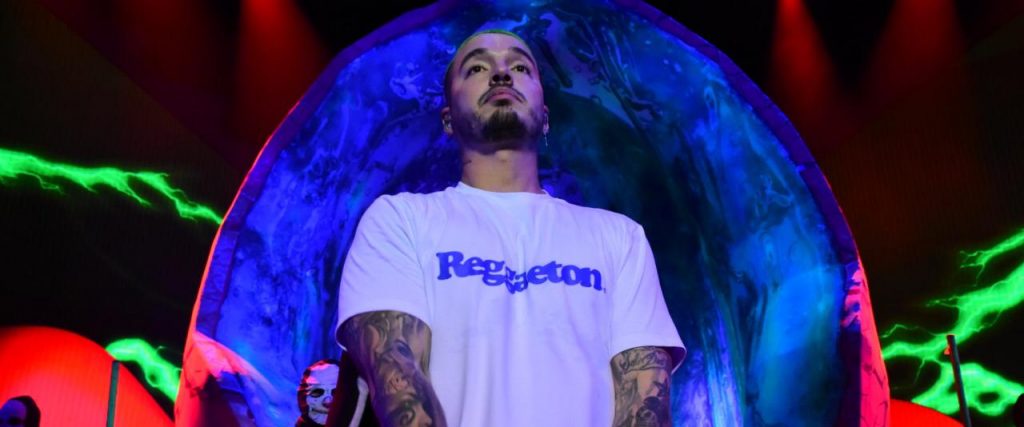Shortly after picking up a Latin Grammy win for Best Urban Album for Vibras in November 2018, J Balvin dropped his single “Reggaetón,” complete with a video that directly pays tribute to the genre’s Puerto Rican titans. Referencing influential figures like Tego Calderón, Daddy Yankee, and Wisin, the video features shots of cuchifritos, Puerto Rican flag tank tops, and bodega exteriors before cutting to Balvin, outfitted in a Barrio Fino tee, singing in front of a collage of artist photos from the genre’s earlier days. Produced by DJ Blass, a key figure in the transformation and proliferation of the genre since the early 2000s, “Reggaetón” marks a distinct choice to honor the roots and lineage of music that’s launched Balvin’s career – and the sound that he distanced himself from in the promotion of Vibras. And in the year that followed the release of the album, Balvin has proven that he is opening a new chapter in his career, one where he is expected to continue breaking barriers for Latino artists while also speaking to the communities that helped him achieve this level of visibility.
In an interview with NPR in anticipation of the album, Balvin articulated his global aspirations for the project’s reach quite clearly, while also foreseeing the challenge that Spanish-language artists face in attaining U.S. and international recognition. “The key here is that we’ve been showing the world that we’re not one-hit wonders when it comes to global [reach]…We made it with the fact that we want everybody to love the album, even though they don’t understand what I’m saying.” Without specifying reggaetón as the anchoring sound of the album and his career, he continued, “Every song is a different vibe,” referencing the LP’s namesake to describe the multiplicity of sounds on the project, which includes pop-reggaetón, 108-bpm bangers, acoustic ballads, and flamenco-referencing R&B.
The album arrived in an industry climate that recognizes Latino artists only “when they’re supposedly booming or crossing over,” as Buzzfeed’s Pier Dominguez wrote at the end of 2017. In this environment, Balvin has maintained a steady pace that perhaps reached peak visibility with the release of “Mi Gente” with Willy William. The Colombian star told Remezcla that the song represented a sonic democratization. “When you hear ‘Mi Gente,’ you’re not totally sure where the beat is from,” he said. It ended up being a winning strategy that, following the Beyoncé feature, peaked at no. 3 on the Billboard Hot 100. Reinforcing the “universal,” or “global” rhythm pivot, “Mi Gente” falls into a sound somewhere between EDM and moombahton, much like follow-up single “Machika” with Jeon and Anitta. Attempting a similarly internationalized, genre-transcending strategy, “Machika” reached no. 10 on the Billboard Hot Latin Songs chart in comparison. When he’s honing in on a specific sound, Balvin has made efforts to reach out to producers from those worlds to help him out; he tapped Afro Bros for “X” with Nicky Jam, and Tainy and DJ Blass for “Reggaetón,” which edges closer to mid-2000s perreo.
Balvin has continued to thrive as he notches more breakthrough moments for the Latino music industry, challenging the long-held assumption that música urbana belongs in a separate part of the U.S. pop landscape. His feature on the Pete Rodriguez-sampling “I Like It” alongside Cardi B and Bad Bunny landed a no. 1 placement on the Billboard Hot 100, and “Ay Vamos” became the first reggaetón track to achieve a billion views on YouTube. The Colombian artist has penetrated the zeitgeist and demonstrated the depth of his influence – Obama sang his praises for Balvin and reggaetón on the campaign trail in Las Vegas and he is the first solo reggaetonero to perform at Coachella. And to top it all off, the artist’s recurring appearances on U.S.-based late night talk shows show that música urbana doesn’t have to be the exception to the rule.

But even before Energía, Balvin showed he had ambitions beyond the world of reggaetón, presenting himself foremost as a “global pop” artist with roots in música urbana. An interview with Milenio.com that followed the release of “Mi Gente” was foretelling. ”I no longer make music for Latinos,” he said. “I want my music to be heard by the human race,” indicating at once an acknowledgement of his beginnings, and the limitations of this framing (and segmentation) as a Latino artist in the global music market.
It seems that Balvin might now fully aspire to uproot archaic notions of the mainstream.
His international ambition calls to mind the strategy of artists like Drake, who has used Afrobeats and dancehall to amplify his reach beyond hip-hop and R&B audiences (Drake’s use of these sounds have sparked a dialogue about his track record of omitting credit for the creators from which he draws influence). Though Drake comes from a distinct cultural context as an English-language black artist, there is an undeniable parallel in their approach.
So what changed to bring Balvin back to acknowledging his perreo-powered beginnings? One theory is that after achieving global fame, he wanted to bring attention to a genre that still has a stigma in the Latino music industry. In his Latin Grammy acceptance speech, Balvin spoke specifically to the genre that launched his career. “I want to share this Grammy with my colleagues, all of the artists in the urban genre,” Balvin said, specifying that for him the award is dedicated to “everyone who is representing the genre and fighting for it, even if at times we have been discriminated [against]…Reggaetón has motivated people to leave the streets and focus on having better dreams and that it’s worth dreaming.” He went on to recognize the new generation of urbano artists. “With all respect to all the artists who are legends, and who will continue to be, it’s time to create new legends, new motivators.”

Now that he’s returned to what he calls his roots (“y si el pueblo pide/no se lo voy a negar,” he sings on “Reggaetón”), is this an artistic evolution that allows space for swift jumps between genres and communities like Drake, seen most pointedly on More Life? Since More Life travels between hip-hop, South African house, grime, and beyond, Drake more fully embodies the ethos that “where you’re at is where you’re from,” as the Rakim lyric puts it.
Much like Drake, it seems that Balvin might now fully aspire to uproot archaic notions of the mainstream and enjoy today’s increasingly genre-agnostic sonic landscape, opening the door for other mainstream Latino artists to do the same, even if they come from different worlds (consider Bad Bunny’s genre-defying album X100PRE). Or is “Reggaetón” a hint at Balvin’s aspiration to again center the genre in his work, now that he’s managed to fully infiltrate the mainstream? Whatever step in his evolution comes next, Balvin is fully positioned to continue disrupting expectations for Latinos, showing that artists can at once honor their identities while also forging new paths for Spanish-speaking artists.







